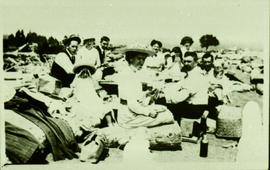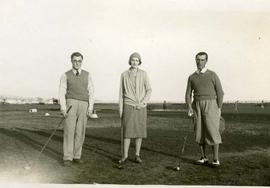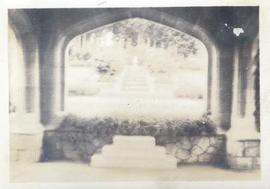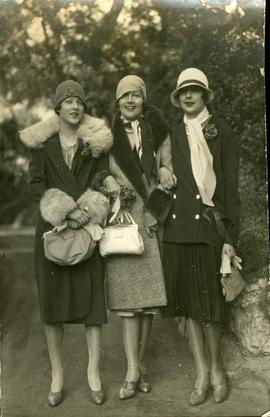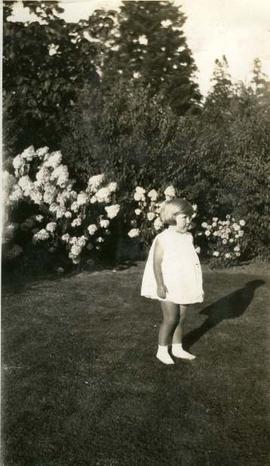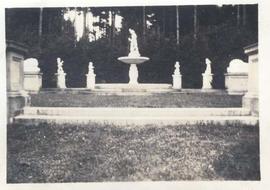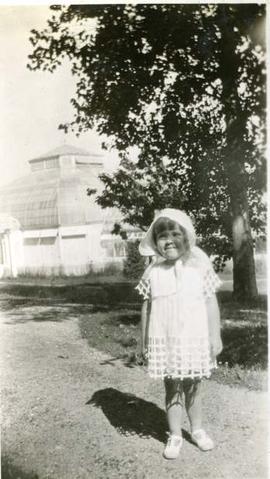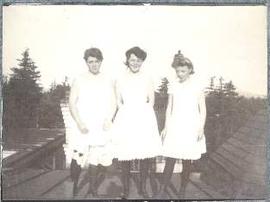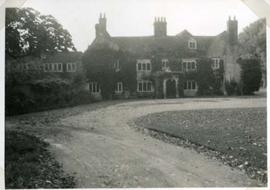Laura Dunsmuir is on the left, holding a parasol
Hatley Castle was designed by renowned British Columbia architect Samuel Maclure for James Dunsmuir. Using only the finest materials, builders, stonemasons and detail carpenters only took 18 months to construct the building from 1908 until 1910. The Italian garden to the west of the castle and the croquet lawn below was added as part of extensive development of the Hatley Park estate by Boston based landscape architects, Brett and Hall from 1912-1914.
When Laura Dunsmuir died in 1937, the house and grounds were maintained by a skeleton staff until it was sold to the Canadian Government in 1940.
In 1913, James Dunsmuir acquired a wooden structure created by the Kwakwaka'wakw people to be used as a gate entrance to the Japanese garden. The sculpture was carved from western red cedar and had three upright pieces joined by a horizontal lintel. The picture shows their position on the grounds of Hatley Park. The sculpture was located at the Dunsmuir property from 1913-1938. The posts were originally intended for the inside of a house in Dzawadi and were carved around 1884, but the house was never completed and the house posts were left until they were bought by a collector who later sold them to James Dunsmuir. Dzawadi is about 100km northeast of Alert Bay and within the traditional territory of the Da’naxda’xw Awaetlala First Nation.
In 1938, after Laura Dunsmuir’s death, the posts were sold to George Heye, who was a well-known collector of anthropological and archeological artefacts of the Americas. The posts were part of the collection at the Museum of the American Indian in New York until 1975 when they were bought by the National Museum of Canada.
A conservator's report from the Canadian museum shows that the posts were damaged before they were positioned at Hatley Park. Careful restoration work had occurred when the house posts were relocated to the Dunsmuir estate. New wood pieces had been skillfully added to replace damage caused by a grass fire in its original location. A second, less careful restoration took place sometime after 1936, provable by the fact that pages of newspaper from that year were found used as filling material under a crude plaster and papier mache repair.
L to R: Maye, Marion, Kathleen, Laura, James, Elinor, Bessie, Muriel.
James Jr., known as Boy by his immediate family, and born in January 1894, is dressed the same as his sisters. In the 19th century, boys and girls were dressed alike until aged about 4. At this time, boys would have a 'breeching ceremony' where their hair would be cut short and they would wear their first pair of trousers. Although less common by the end of the 1800s, the Dunsmuir family followed this tradition.
L to R: Maye, Elinor, Bessie, Muriel, Marion, Kathleen, James.
James Jr., known as Boy by his immediate family, and born in January 1894, is dressed the same as his sisters. In the 19th century, boys and girls were dressed alike until aged about 4. At this time, boys would have a 'breeching ceremony' where their hair would be cut short and they would wear their first pair of trousers. Although less common by the end of the 1800s, the Dunsmuir family followed this tradition.
Hatley Castle was designed by renowned British Columbia architect Samuel Maclure for James Dunsmuir. Using only the finest materials, builders, stonemasons and detail carpenters only took 18 months to construct the building from 1908 until 1910. The Neptune Steps and Fountain Court to the north of the castle were added as part of extensive development of the Hatley Park estate by Boston based landscape architects, Brett and Hall from 1912-1914.
When Laura Dunsmuir died in 1937, the house and grounds were maintained by a skeleton staff until it was sold to the Canadian Government in 1940.
Hatley Castle was designed by renowned British Columbia architect Samuel Maclure for James Dunsmuir. Using only the finest materials, builders, stonemasons and detail carpenters only took 18 months to construct the building from 1908 until 1910. This image, taken under the porte-cochere, shows a horse mounting block as well as the view from the castle front doors. The Neptune steps and Fountain Court to the north of the castle were added as part of extensive development of the Hatley Park estate by Boston based landscape architects, Brett and Hall from 1912-1914.
The Neptune Steps and fountain court to the north of the castle was added as part of extensive development of the Hatley Park estate by Boston based landscape architects, Brett and Hall from 1912-1914. This images shows that the lions were initially at the top of the steps, although they were moved to their current location at the foot of the steps during the Dunsmuir era at Hatley Park.
L to R: Elinor, ?, Muriel
The Hatley Park estate was developed from 1912-1914 by Boston based landscape architects, Brett and Hall. This included addition of a new entrance on Sooke Road that would bring the visitor down a winding, serpentine road to the main house. An extensive network of roads and trails were added to the estate. In 1913, Hermann Eng was hired as head gardener. He and his wife Theresa lived in the Sooke Road gatehouse for almost 20 years.
The Italian garden to the west of the castle was added as part of extensive development of the Hatley Park estate by Boston based landscape architects, Brett and Hall from 1912-1914. This image looks between shrubs to the loggia. A birdbath and urn are visible.
Probably Kathleen Dunsmuir
image is inscribed with "With best love [signature illegible]. 29-9-28"
Class photograph. Whereas recruits were assigned alphabetically to flights, classes were a mix of surnames.



